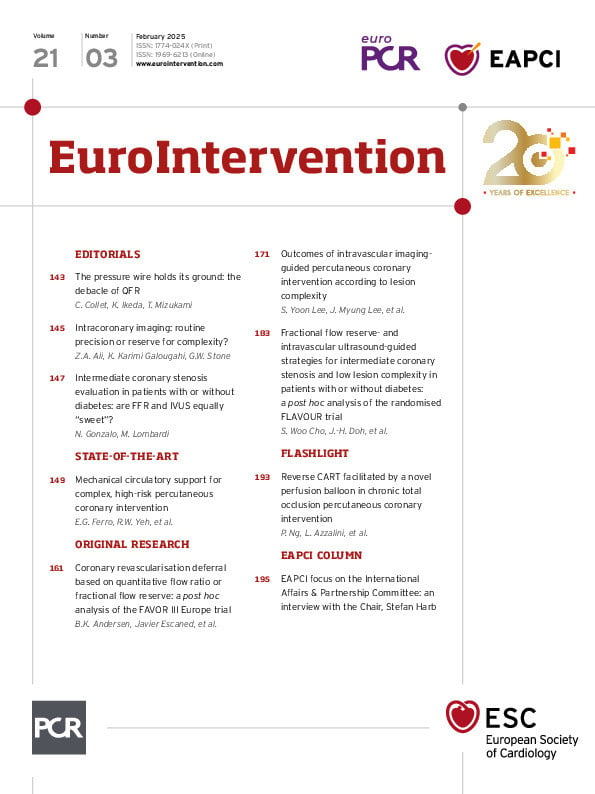Abstract
Background: Recent trials have shown that intravascular imaging (IVI)-guided percutaneous coronary intervention (PCI) improves clinical outcome, as compared to angiography-guided PCI, in complex coronary artery lesions. However, it is unclear whether this benefit is affected by overall lesion complexity in each patient.
Aims: The present study sought to investigate the impact of overall lesion complexity on the benefit of IVI-guided PCI.
Methods: A total of 4,611 patients with complex coronary artery lesions from the RENOVATE-COMPLEX-PCI trial (n=1,639) and the institutional registry of the Samsung Medical Center (n=2,972) were classified according to the number of complex lesion features found in each patient. The primary outcome was target vessel failure (TVF) at 3 years, a composite of cardiac death, target vessel myocardial infarction, or target vessel revascularisation.
Results: The cutoff value for the number of complex lesion features to predict TVF, determined using the maximally selected log-rank test, was 3. Patients with ≥3 complex lesion features had a higher risk of TVF than those with <3 complex lesion features (11.0% vs 7.2%, hazard ratio [HR] 1.59, 95% confidence interval [CI]: 1.28-1.96; p<0.001). IVI-guided PCI significantly reduced the risk of TVF compared with angiography-guided PCI in both groups (≥3 complex lesion features: 7.4% vs 14.4%, HR 0.49, 95% CI: 0.35-0.69; p<0.001; <3 complex lesion features: 5.7% vs 8.1%, HR 0.72, 95% CI: 0.53-0.98; p=0.039). The benefit of IVI-guided PCI tended to increase as the number of complex lesion features increased (absolute risk reduction for TVF: –0.012 vs –0.027 vs –0.055 vs –0.077, respectively, for 1 vs 2 vs 3 vs ≥4 complex lesion features; interaction p=0.048).
Conclusions: In patients with complex coronary artery lesions, IVI-guided PCI showed a lower risk of TVF across all degrees of lesion complexity. The prognostic benefit of IVI-guided PCI tended to increase as patients had more complex lesion features. (RENOVATE-COMPLEX-PCI [ClinicalTrials.gov: NCT03381872]; Institutional cardiovascular catheterisation database of the Samsung Medical Center [ClinicalTrials.gov: NCT03870815]).
Sign up for free!
Join us for free and access thousands of articles from EuroIntervention, as well as presentations, videos, cases from PCRonline.com

